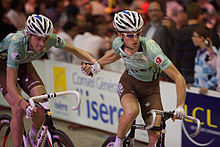Sling handle

The sling grip is a form of replacement in two-man team driving .
A technology to transfer the kinetic energy or the impulse ("momentum") from the relieved driver to the releasing driver was necessary in the early days of the sport so that the releasing driver would not be able to use his own strength every time he relieved from about 30 to up to 50 km / h had to accelerate (see section history ). The technique of the sling grip developed from this .
history
In the six-day races, which were held in the early days of cycling , the riders took turns "on sight", with the rider entering the race having to accelerate strongly under his own steam. The drivers therefore often complained of knee problems.
For this reason, before the development of the sling handle and among amateurs up until the 1980s, a push-on technique was used instead of the sling handle: In an inside pocket on the left side of the driver's trousers there was a knob approx. 12 cm long and 4-5 cm thick ( made of material rolled up and held together with adhesive tape), made clearly visible on the outside by a quilted white seam line. This was grabbed by the team mate as he approached and the colleague was then pushed, in racing jargon “pushed in” or “pushed into the race”. Since the total stroke of the detachment process is much shorter with this technology, it required significantly higher forces than the sling grip or was not suitable for bridging greater speed differences between the drivers.
The sling grip was initially only used by professionals (since the 1970s), but has also been used by amateurs and juniors since around 1990.
technology
The starting point for this technique is the regulations for two-man team driving: Of the two athletes on the track, only one is ever in the race, i.e. H. in the rating. The other can fall back at a slow speed (25 - 35 km / h) only to be overtaken by his colleague after about one or two laps (from his point of view). By pushing with the sling grip , he can accelerate to the pace of the field in seconds without great effort (approx. 45 - 55 km / h) and continue the race in place of his colleague.
Technically, the sling grip is quite demanding, which is why it was banned for a long time by amateurs. Both drivers have to hold the handlebars with one hand during the entire process. The driver approaching from behind keeps his left hand on the handlebars and holds it on the upper handlebar near the stem, while the driver in front holds the handlebars with his right hand in the bracket (below) and holds the left hand on the outstretched hand of his partner " withdraws ".
Both the (earlier) push-on technology and the replacement by means of a sling grip also place high demands on the competitors, because the successor must bypass both drivers of the replacing team in good time in order not to run into them ("drive into the replacement") and causing a fall.
literature
- Jan Eric Schwarzer : The two-man team cycling in track cycling. Technical description, requirement profile and forms of exercise. University thesis. German Sport University Cologne , Cologne 2009 (diploma thesis)
Web links
- Slingshot handles in the 6-day race: Madison Day 1 ( Memento from July 13, 2015 in the Internet Archive ) youtube

